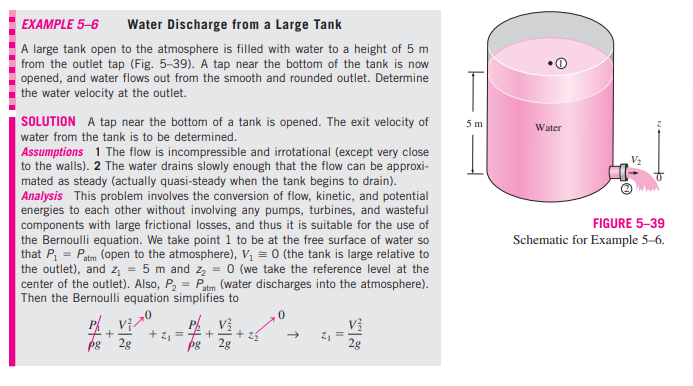EXAMPLE 5–6 Water Discharge from a Large Tank A large tank open to the atmosphere is filled with water to a height of 5 m from the outlet tap (Fig. 5–39). A tap near the bottom of the tank is now opened, and water flows out from the smooth and rounded outlet. Determine the water velocity at the outlet. •0 T |SOLUTION A tap near the bottom of a tank is opened. The exit velocity of water from the tank is to be determined. 5 m Water Assumptions 1 The flow is incompressible and irrotational (except very close to the walls). 2 The water drains slowly enough that the flow can be approxi- mated as steady (actually quasi-steady when the tank begins to drain). Analysis This problem involves the conversion of flow, kinetic, and potential energies to each other without involving any pumps, turbines, and wasteful components with large frictional losses, and thus it is suitable for the use of the Bernoulli equation. We take point 1 to be at the free surface of water so that P = Patm (open to the atmosphere), Vị = 0 (the tank is large relative to the outlet), and z, = 5 m and z, = 0 (we take the reference level at the center of the outlet). Also, P, = Patm (water discharges into the atmosphere). Schematic Then the Bernoulli equation simplifies to P vị 2=#+ 2g 2g 2g
EXAMPLE 5–6 Water Discharge from a Large Tank A large tank open to the atmosphere is filled with water to a height of 5 m from the outlet tap (Fig. 5–39). A tap near the bottom of the tank is now opened, and water flows out from the smooth and rounded outlet. Determine the water velocity at the outlet. •0 T |SOLUTION A tap near the bottom of a tank is opened. The exit velocity of water from the tank is to be determined. 5 m Water Assumptions 1 The flow is incompressible and irrotational (except very close to the walls). 2 The water drains slowly enough that the flow can be approxi- mated as steady (actually quasi-steady when the tank begins to drain). Analysis This problem involves the conversion of flow, kinetic, and potential energies to each other without involving any pumps, turbines, and wasteful components with large frictional losses, and thus it is suitable for the use of the Bernoulli equation. We take point 1 to be at the free surface of water so that P = Patm (open to the atmosphere), Vị = 0 (the tank is large relative to the outlet), and z, = 5 m and z, = 0 (we take the reference level at the center of the outlet). Also, P, = Patm (water discharges into the atmosphere). Schematic Then the Bernoulli equation simplifies to P vị 2=#+ 2g 2g 2g
Elements Of Electromagnetics
7th Edition
ISBN:9780190698614
Author:Sadiku, Matthew N. O.
Publisher:Sadiku, Matthew N. O.
ChapterMA: Math Assessment
Section: Chapter Questions
Problem 1.1MA
Related questions
Question
Write what you understand in this example.

Transcribed Image Text:EXAMPLE 5–6
Water Discharge from a Large Tank
A large tank open to the atmosphere is filled with water to a height of 5 m
from the outlet tap (Fig. 5-39). A tap near the bottom of the tank is now
opened, and water flows out from the smooth and rounded outlet. Determine
the water velocity at the outlet.
T
SOLUTION A tap near the bottom of a tank is opened. The exit velocity of
5 m
Water
water from the tank is to be determined.
Assumptions 1 The flow is incompressible and irrotational (except very close
to the walls). 2 The water drains slowly enough that the flow can be approxi-
mated as steady (actually quasi-steady when the tank begins to drain).
Analysis This problem involves the conversion of flow, kinetic, and potential
energies to each other without involving any pumps, turbines, and wasteful
components with large frictional losses, and thus it is suitable for the use of
the Bernoulli equation. We take point 1 to be at the free surface of water so
that P, = Patm (open to the atmosphere), V, = 0 (the tank is large relative to
the outlet), and z = 5 m and z, = 0 (we take the reference level at the
center of the outlet). Also, P, = Patm (water discharges into the atmosphere).
Then the Bernoulli equation simplifies to
FIGURE 5-39
Schematic for Example 5-6.
P Vị-
V?
+ z, =++
2g
2g
2g
... ...
Expert Solution
This question has been solved!
Explore an expertly crafted, step-by-step solution for a thorough understanding of key concepts.
This is a popular solution!
Trending now
This is a popular solution!
Step by step
Solved in 2 steps

Knowledge Booster
Learn more about
Need a deep-dive on the concept behind this application? Look no further. Learn more about this topic, mechanical-engineering and related others by exploring similar questions and additional content below.Recommended textbooks for you

Elements Of Electromagnetics
Mechanical Engineering
ISBN:
9780190698614
Author:
Sadiku, Matthew N. O.
Publisher:
Oxford University Press

Mechanics of Materials (10th Edition)
Mechanical Engineering
ISBN:
9780134319650
Author:
Russell C. Hibbeler
Publisher:
PEARSON

Thermodynamics: An Engineering Approach
Mechanical Engineering
ISBN:
9781259822674
Author:
Yunus A. Cengel Dr., Michael A. Boles
Publisher:
McGraw-Hill Education

Elements Of Electromagnetics
Mechanical Engineering
ISBN:
9780190698614
Author:
Sadiku, Matthew N. O.
Publisher:
Oxford University Press

Mechanics of Materials (10th Edition)
Mechanical Engineering
ISBN:
9780134319650
Author:
Russell C. Hibbeler
Publisher:
PEARSON

Thermodynamics: An Engineering Approach
Mechanical Engineering
ISBN:
9781259822674
Author:
Yunus A. Cengel Dr., Michael A. Boles
Publisher:
McGraw-Hill Education

Control Systems Engineering
Mechanical Engineering
ISBN:
9781118170519
Author:
Norman S. Nise
Publisher:
WILEY

Mechanics of Materials (MindTap Course List)
Mechanical Engineering
ISBN:
9781337093347
Author:
Barry J. Goodno, James M. Gere
Publisher:
Cengage Learning

Engineering Mechanics: Statics
Mechanical Engineering
ISBN:
9781118807330
Author:
James L. Meriam, L. G. Kraige, J. N. Bolton
Publisher:
WILEY